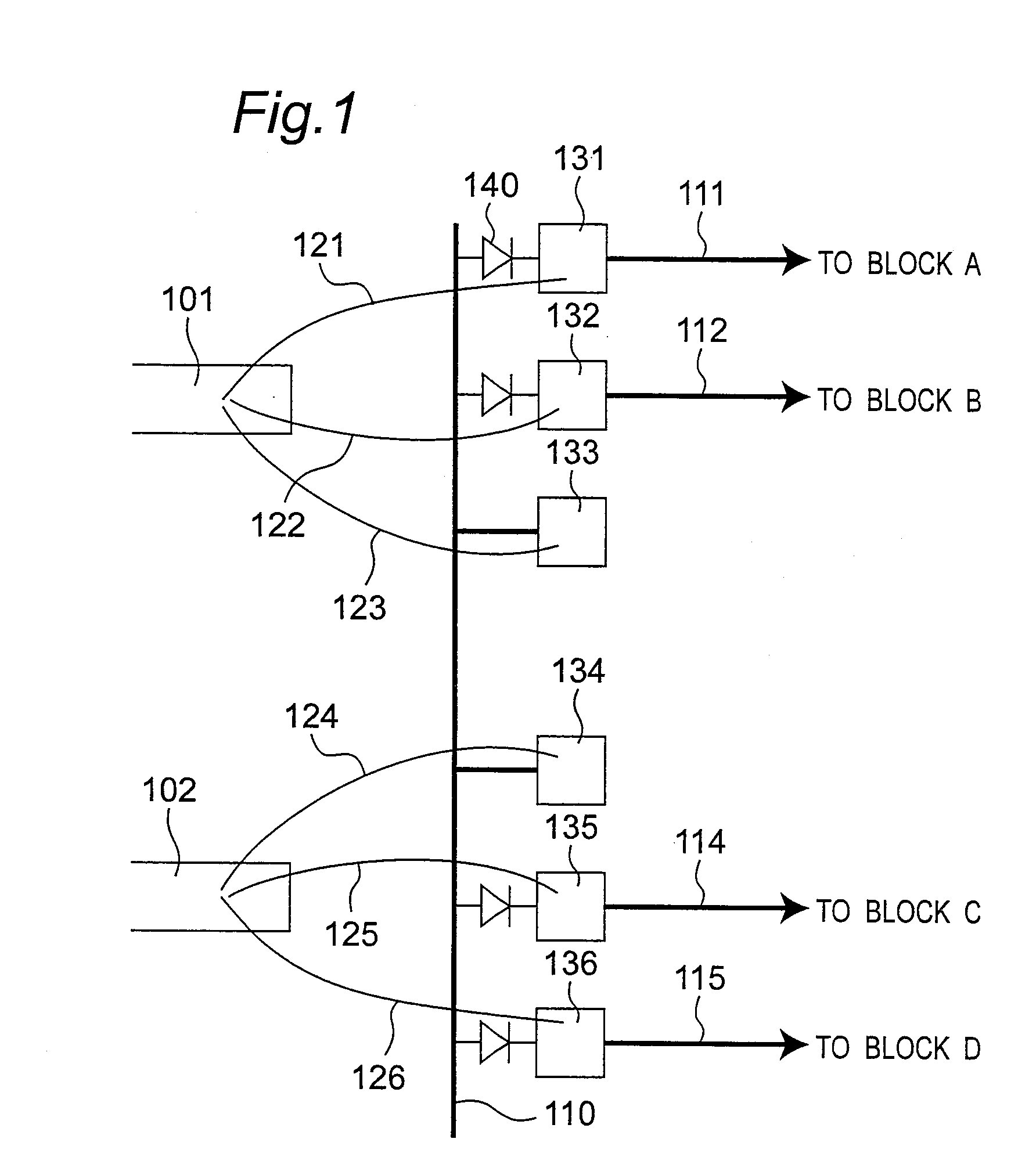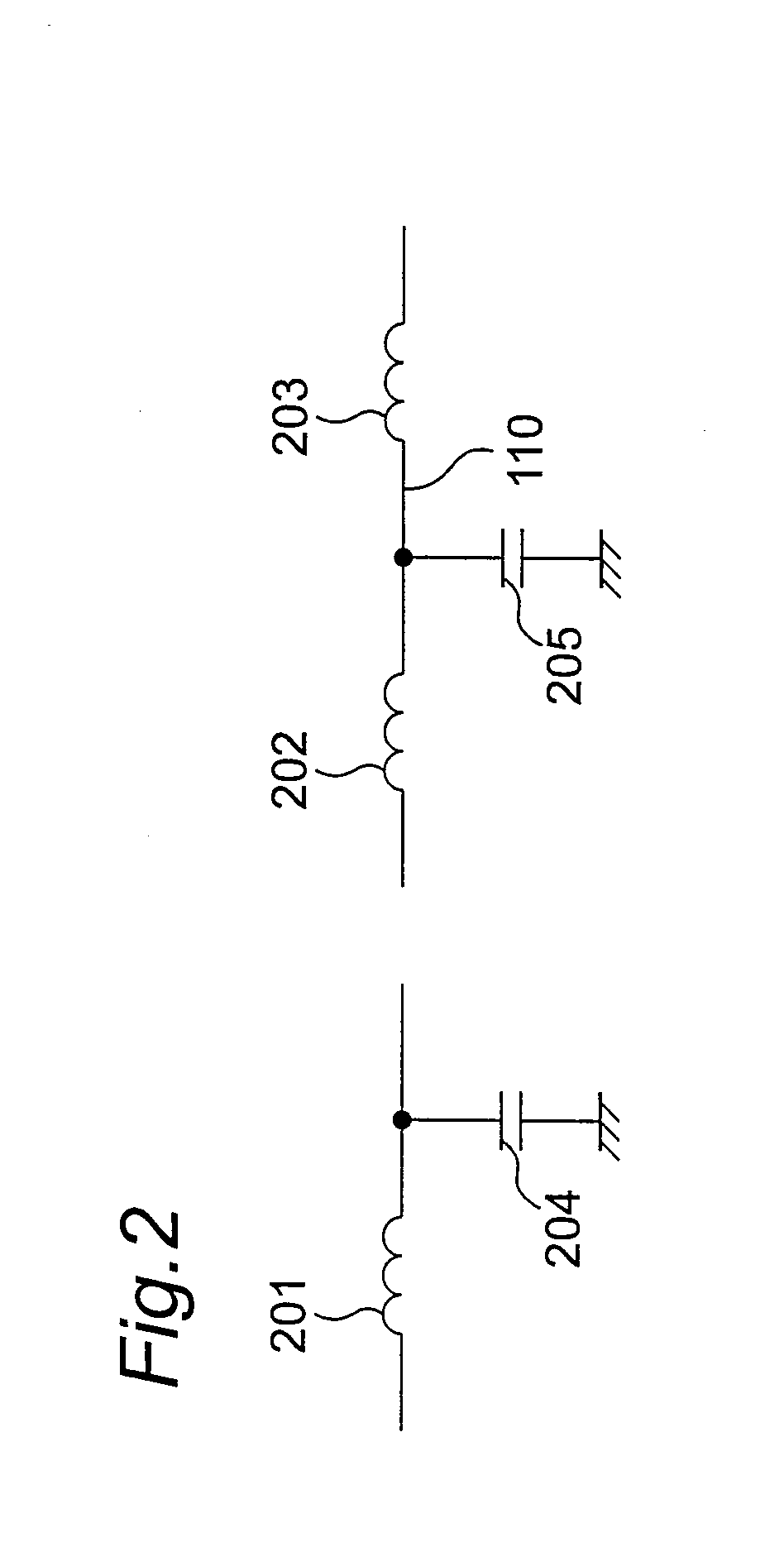Semiconductor integrated circuit device
a technology of integrated circuit and semiconductor, which is applied in the direction of semiconductor devices, semiconductor/solid-state device details, diodes, etc., can solve the problems of noise interference between the blocks, difficulty in adequately lowering the impedance at the single connection point, and increasing the noise level, so as to suppress noise interference, prevent electrostatic breakdown, and reduce the impedance
- Summary
- Abstract
- Description
- Claims
- Application Information
AI Technical Summary
Benefits of technology
Problems solved by technology
Method used
Image
Examples
first embodiment
[0023]With reference to FIGS. 1 and 2, a first embodiment of the present invention will be described below. As shown in FIG. 1, a semiconductor IC device according to the first embodiment comprises a first lead frame 101, and two block-dedicated pads 131, 132 which are associated, respectively, with a block A and a block B, and provided for connection between the first lead frame 101 and each of the blocks A, B. The block-dedicated pad 131 is connected to an intra-chip wire 111 connected to the block A, and further connected to a block-dedicated wire 121 for the block A, and an inter-lead-frame connection line 110 for interconnecting between the first lead frame 101 and other lead frame, such as an after-mentioned second lead frame 102. The block-dedicated pad 132 is connected to an intra-chip wire 112 connected to the block B, and further connected to a block-dedicated wire 122 for the block B, and the inter-lead-frame connection line 110. The semiconductor IC device further includ...
second embodiment
[0030]With reference to FIG. 3, a second embodiment of the present invention will be described below. In FIG. 3, the same component or element as that in the first embodiment illustrated in FIG. 1 is defined by the same reference numeral or code, and its detailed description will be omitted. In the semiconductor IC device according to the first embodiment which is designed to connect the block-dedicated and connection wires to each other at a single point on the lead frame (101, 102) by a wire bonding process so as to reduce noise interference, the wire connections and the inter-lead-frame connection line 110 are effective in preventing electrostatic breakdown after the wire bonding process. However, the semiconductor IC device according to the first embodiment cannot prevent electrostatic breakdown during and before the wire bonding process.
[0031]In a semiconductor IC device according to the second embodiment, as shown in FIG. 3, an electrostatic-breakdown protection element 301 is...
third embodiment
[0032]With reference to FIGS. 5 to 7, a third embodiment of the present invention will be described below. In FIGS. 6 and 7, the same component or element as that in the first embodiment illustrated in FIG. 1 is defined by the same reference numeral or code, and its detailed description will be omitted. As compared with the first and second embodiments, a semiconductor IC device according to the third embodiment is deigned to more efficiently protect against electrostatic breakdown in more small surface area.
[0033]Specifically, as shown in FIG. 5, in the semiconductor IC device according to the third embodiment, a semiconductor substrate having a first conductivity type has a first well having a second conductivity type which is opposite to the first conductivity type, and a second well having the first conductivity type exists in the first well. Further, an electrostatic-breakdown protection element is connected between a source line and a ground line. The ground line is divided in...
PUM
 Login to View More
Login to View More Abstract
Description
Claims
Application Information
 Login to View More
Login to View More - R&D
- Intellectual Property
- Life Sciences
- Materials
- Tech Scout
- Unparalleled Data Quality
- Higher Quality Content
- 60% Fewer Hallucinations
Browse by: Latest US Patents, China's latest patents, Technical Efficacy Thesaurus, Application Domain, Technology Topic, Popular Technical Reports.
© 2025 PatSnap. All rights reserved.Legal|Privacy policy|Modern Slavery Act Transparency Statement|Sitemap|About US| Contact US: help@patsnap.com



